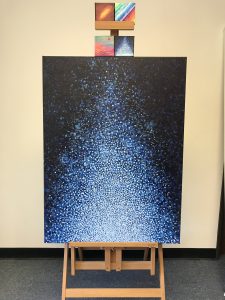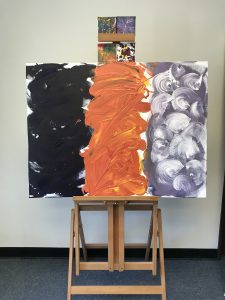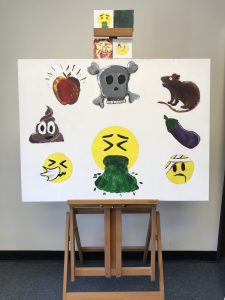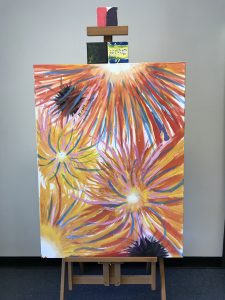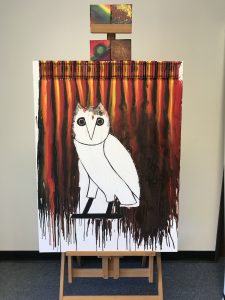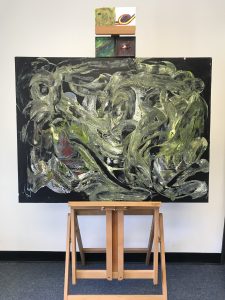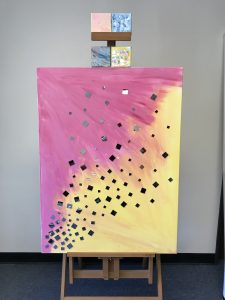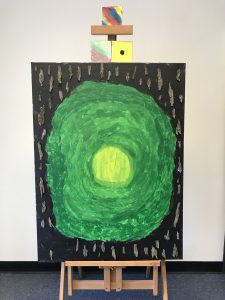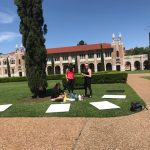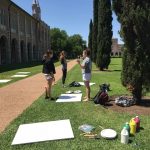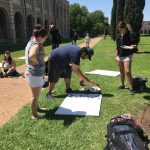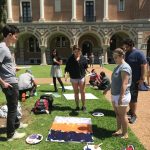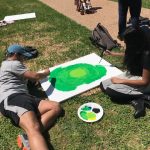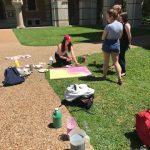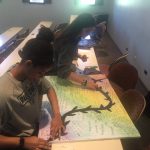“Art of Emotion”
Ten groups of students in Psychology 353: Introduction to Emotion and Motivation chose an emotion to study and presented their findings to the class. As part of their research, students created art on canvases to capture the development, experience, or purpose of the emotion. The goal of this unit was to bring about a coalescence of information and experience for course materials beyond what the typical social sciences classrooms provide.
This program was funded by a Brown Teaching Grant from Rice University
Sandra Parsons, Ph.D.
Assistant Teaching Professor
Department of Psychology
Title: “Awe”
Artists:
Kylie Burgess, Hanszen college, Class of 2019, Psychology & Kinesiology
Christian Capo, Will Rice college, Class of 2018, Psychology & Policy Studies
Alina Chen, Sid Richardson college, Class of 2018, Psychology
Cindy Nguyen, Wiess college, Class of 2018, Psychology & Studio Art
Materials: Acrylic paint, canvas
The goal of our painting is to remind every individual who looks at it how they feel when experiencing awe. Awe is a self-diminishing emotion, drawing one’s attention externally rather than internally. Through the use of contrasts, detail, and movement, our hope is to captivate viewers, prompting them to become momentarily absorbed in its calm blue hues.
Title: “The Process of Creativity”
Artists:
Miranda Proctor, Duncan College, Class of 2018, English & Psychology
Luis Zelaya, Sid Richardson College, Class of 2018, Cognitive Sciences
Jake Johnston, Baker College, Class of 2019, Psychology
Savannah Lawrence, Wiess College, Class of 2019, Psychology
Material: Acrylic paint, canvas
Our painting is a linear representation of the stages of creativity. The first stage (left) symbolizes the confusion we feel when we are searching our minds for inspiration to spark creativity. The dark swirls of color contain flashes of blues and purples to depict the flashes of ideas we may have but quickly discard in search for something “better.” Creativity strikes in the center, portrayed through erratic paint strokes and bright colors to reflect the energetic, arousing, and flow-like state. Finally, clouds of healing and tranquility wash over you as the creative state comes to an end.
Title: “Modern Disgust”
Artists:
Laney Brown, Jones College, Class of 2018. Cognitive Sciences and Psychology
Meera Devarajan, Hanszen College, Class of 2018, Cognitive Sciences
Varsha Sathappan, Hanszen College, Class of 2018, Psychology
Donni Staley, McMurtry College, Class of 2018, Psychology
Materials: Acrylic paint, canvas
Our work uses acrylic paint to depict disgust and its seven domains. At the center of the piece, we have disgust represented by the “vomiting” emoji. Feeling nauseous is a common visceral reaction experienced during disgust, and thus, serves as a physical representation of the emotional state. Research has shown that there are seven domains that commonly elicit a disgust response. For that reason, we surrounded the depiction of disgust with seven emojis that embody these domains: hygiene, body products, food, death, animals, sex, and envelope violations. The arrangement displays how several factors can contribute and combine to evoke disgust.
Title: “Forgiveness”
Artists:
Madison Blattel McMurtry, Class of 2018, Psychology,
Elisabeth Kalomeris Martel, Class of 2018,Psychology and Policy Studies,
Tyler de Salazar, Wiess, Class of 2018, Chemical Engineering
Materials: acrylic paint, canvas
Description: This painting is intended to evoke feelings of forgiveness. Specifically, forgiveness is an experience of increased positive emotions which is represented by the bright bursts of color, but also has potential negative effects in certain contexts which is represented by the darker, smaller bursts of colors. The interplay of these colors bleeding and expanding towards each other reflect how we let go of our anger and forgive others for their transgressions. We hope the viewer walks away from this painting with the feeling of weight being lifted off their shoulders and a lightness like the effects of forgiveness.
Title: “Aporia”
Artists:
Bailey Douglas, Lovett, Class of 2019, Psychology and Sport Management
Elijah Li, McMurtry, Class of 2019, Psychology and Kinesiology
Haden Tobola, Martel, Class of 2019, Psychology and Kinesiology
Janet Fan, Baker, Class of 2019, Psychology
Materials: Acrylic paint, tempera paint, sharpie, glue, and crayons on canvas.
The goal of our piece was to showcase the duality of our emotion, embarrassment. We chose an owl as our subject because it is representative of Rice students as a whole. The melted crayons were an effort to mimic the flood of embarrassment and warmth that engulfs you after you do something embarrassing. Not only are we showcasing the unfortunate side of embarrassment with the shocked-looking owl, but the warm colors also stir feelings of positivity in the viewer. Embarrassed reactions can create a non-verbal apology for embarrassing actions, making the subject appear warmer, more human, and friendlier to onlookers.
Title: “The Growth of Gratitude”
Artists:
Stephanie Mendivil, Sid Richardson College, Class of 2018, Psychology and Kinesiology
Rebecca Godard, Sid Richardson College, Class of 2019, Psychology
Shani Rainey, McMurtry College, Class of 2019, Psychology and Kinesiology
Shelby Livingstone, Will Rice College, Class of 2018, Cognitive Science and Psychology
Materials: Paper, Scissors, Rubber Cement, Sharpies, Dry Pastels, Black Paper, Canvas
We asked our classmates to write thank you letters or write about what they are thankful for. After attaching them to the board, we used dry pastels to create a rainbow effect through the entire canvas. Finally, we topped it with a black vine, to represent the role of gratitude in motivating personal and societal growth.
Title: “Regret”
Artists:
Eun-Bit Chang, Sid Class of 2018, Psychology,
Jacqueline Edmonds, Sid Class of 2019, Psychology
Tien Nguyen, Martel Class of 2018, Psychology
Ashton Thrasher, Sid Class of 2018, Sociology/Anthropology
Materials: canvas, acrylic paint, Floetrol Paint Conditioner, silicone
An acrylic pour technique was used to illustrate the complex and consuming feelings of regret.
Title: “Things We Think We’re Supposed to Feel”
Artists:
Naomi Eigbe, Jones College, Class of 2018, Computer Science, Psychology
Maricela Zertuche, Will Rice College, Class of 2018, English
Amera Dixon, Hanszen College, Class of 2019, Biochemistry and Cell Biology
Jacqueline Chamberlain, Will Rice College, Class of 2019, Psychology
Materials: Acrylic paint, mirror shards, sheer fabric, paper
We used pieces of a mirror to form the head to represent the universality of shame by reflecting each person’s face in the anonymous face we created. We overlaid the person’s body with a veil formed from white sheer fabric and cutouts of words from magazine we felt were shame inducing to create the image of this person hiding behind the shame that society creates. We painted a background of grayish-blue with downward strokes as we felt it represented the isolation and confusion that one can experience when hiding in shame, like being adrift alone in the middle of an ocean.
Title: “Beam”
Artists:
Theresa Sonka, Brown College, Class of 2018, Bioengineering
Colleen Phillips, Wiess College, Class of 2018, Psychology
Elizabeth Stone, Brown College, Class of 2018, Psychology
Amanda Pope, Brown College, Class of 2018, Psychology and Political Science
This artwork represents elevation, the emotion felt after witnessing a morally virtuous act. We aimed to capture the physical feeling of elevation and the positive impact of elevation on a community. The warm colors and the arrangement of the tiles growing up and out across the canvas represent the feeling of warmth and radiation coming from the chest when feeling elevation. The mirrors represent the self-reflection aspect of elevation—seeing a moral act makes one want to emulate the behavior. The use of many mirrors represents the potential for elevation to spread across a community by inspiring positive acts.
Materials: Acrylic paint, canvas, mirror tiles, Krazy Glue
Title: “Vulnerability”
Atists:
Khevin Brewer Jr., Jones, Class of 2018, Psychology and Business
Christian Capo, Will Rice, Class of 2018, Psychology and Policy Studies
Karthika Senthilkumar, Will Rice, Class of 2018, Psychology
Materials: Acrylic paint, canvas, tree bark, glue
Influenced by the natural composition of a tree, our painting aims to represent the process of vulnerability. As an individual removes the barriers that conceals their inner most vulnerabilities, the true self is revealed. This is represented though the use of natural tree bark that was removed from the beautiful trees of Rice University, that were placed vertically around the perimeter of the canvas. As you chip away, darker colors such as black transition spirally inward to warmer colors from green to yellow that represent the astonishing power of vulnerability.


